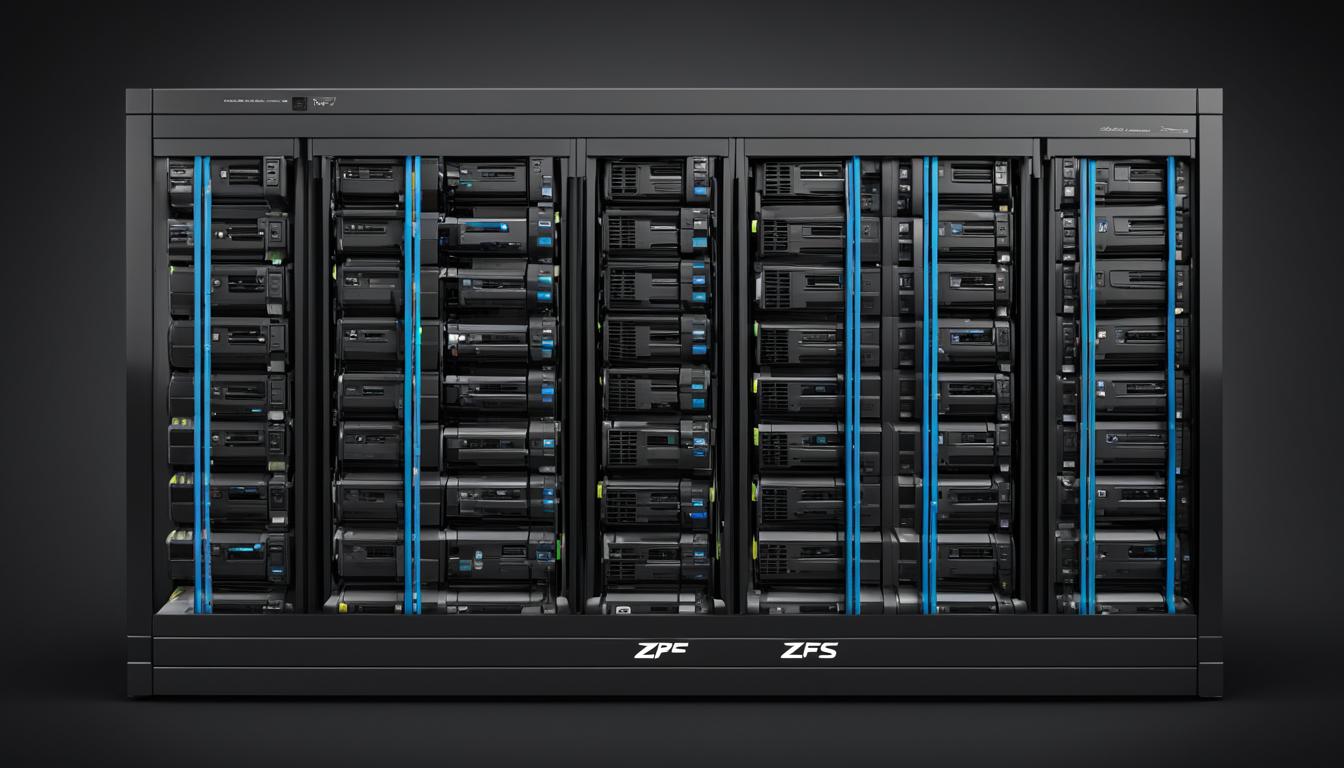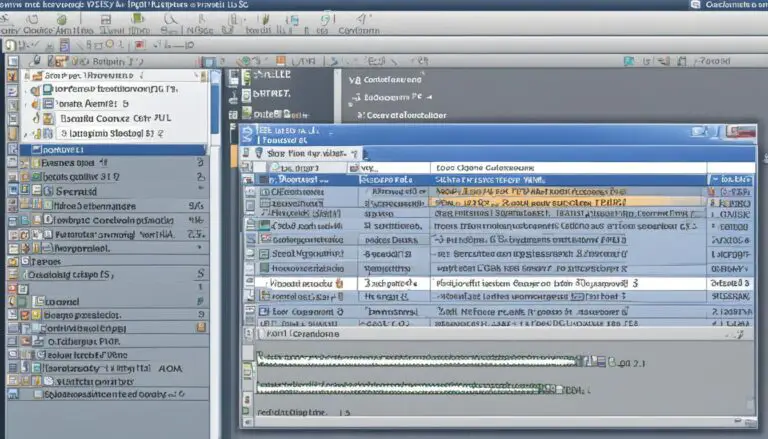Understanding RAIDz2 in ZFS Storage Systems
Hello, and welcome to this article on RAIDz2 in ZFS storage systems. In this section, we will explore the basics of RAIDz2 and gain a better understanding of its configuration and functionality. Whether you are new to ZFS or looking to optimize your storage system, this article will provide valuable insights.
RAIDz2 is a redundancy level in the ZFS file system that offers enhanced data protection. It is a software RAID implementation that is widely used in storage systems requiring high reliability. Unlike traditional RAID levels, RAIDz2 uses double parity, allowing for the simultaneous failure of two drives without data loss.
By leveraging double parity, RAIDz2 provides superior fault tolerance compared to other RAID levels in ZFS. This makes it an ideal choice for environments where data integrity is critical. Furthermore, RAIDz2 offers a balance between redundancy and capacity, enabling efficient use of storage space.
To implement RAIDz2 in ZFS, it is recommended to create a storage pool and configure it with a minimum of four drives. The number of drives can be adjusted based on your specific needs for fault tolerance and storage capacity. It is important to consider factors such as drive size, performance requirements, and future expansion when configuring RAIDz2.
Overall, RAIDz2 in ZFS provides a powerful solution for data protection and fault tolerance. Understanding its principles and implementing it correctly can ensure the optimal operation of your storage system. In the following sections, we will delve deeper into how RAIDz2 works, its benefits, and how to implement it effectively in ZFS.
Key Takeaways:
- RAIDz2 is a redundancy level in the ZFS file system that offers enhanced data protection.
- It uses double parity, allowing for the simultaneous failure of two drives without data loss.
- RAIDz2 provides superior fault tolerance compared to other RAID levels in ZFS.
- It enables efficient use of storage space by offering a balance between redundancy and capacity.
- Implementing RAIDz2 in ZFS involves creating a storage pool and configuring it with the desired number of drives.
How Does RAIDz2 Work in ZFS?
RAIDz2 in ZFS is a powerful redundancy technique that enhances data protection and ensures high fault tolerance in storage systems. Understanding how RAIDz2 works in ZFS is essential for optimizing data integrity and ensuring the reliable operation of storage environments.
RAIDz2 works by distributing data and parity blocks across multiple drives in a storage pool. It utilizes a stripe-based approach, similar to RAID 5, where data is divided into fixed-length blocks. Each block has its own RAID bandwidth, allowing for efficient allocation of storage space.
What sets RAIDz2 apart from other RAID levels in ZFS is its use of double parity. RAIDz2 utilizes two parity blocks for every set of data blocks, providing protection against the simultaneous failure of two drives without compromising data integrity. This level of fault tolerance helps to safeguard critical data and ensures continued access to information even in the event of drive failures.
One of the key features of RAIDz2 in ZFS is its integration of checksums. Checksums are cryptographic hashes calculated for each block of data and parity to detect and correct errors. By verifying the integrity of data during reads and writes, RAIDz2 can identify and recover from data corruption, further enhancing the reliability of the storage system.
Compared to other RAID levels in ZFS, RAIDz2 offers superior fault tolerance and data integrity. It combines the benefits of RAID 5 and RAID 6, offering the ability to withstand the failure of multiple drives while ensuring minimal performance impact and optimal storage efficiency.
To visualize how RAIDz2 works in ZFS, consider the following example:
| Data Blocks | Parity Blocks |
|---|---|
| Drive 1 | Parity 1 |
| Drive 2 | Parity 2 |
| Drive 3 | Parity 3 |
| Drive 4 | Parity 4 |
As shown in the table above, the data blocks and parity blocks are distributed across four drives. In this example, RAIDz2 can sustain the failure of two drives without losing any data or compromising system performance.
Implementing RAIDz2 in ZFS provides users with a robust and reliable storage solution that prioritizes data protection and fault tolerance. By leveraging the striping and double parity capabilities of RAIDz2, organizations can ensure the integrity and availability of their critical data.
Benefits of RAIDz2 in ZFS
RAIDz2 in ZFS offers numerous advantages, making it a highly desirable choice for storage systems. Firstly, it provides a higher level of data protection compared to other RAID levels. With the inclusion of double parity, RAIDz2 can withstand the simultaneous failure of two drives without any data loss. This exceptional resilience makes it particularly valuable in environments where data integrity is paramount.
In addition to its robust data protection capabilities, RAIDz2 also allows for efficient utilization of storage space. By striking a balance between redundancy and capacity, RAIDz2 ensures that valuable storage resources are optimized. This is especially crucial for organizations that need to store vast amounts of data without compromising on performance or affordability.
Furthermore, optimizing the configuration of RAIDz2 in ZFS can greatly enhance the overall performance and resilience of storage systems. By fine-tuning various settings and parameters, users can achieve optimal efficiency, ensuring that their systems operate at peak performance while maintaining data integrity.
RAIDz2 in ZFS brings together the benefits of advanced data protection, storage efficiency, and performance optimization. By combining these features, users can confidently deploy RAIDz2 in ZFS to meet their demanding storage requirements.
The advantages of using RAIDz2 in ZFS can be summarized as:
- Higher level of data protection compared to other RAID levels
- Efficient utilization of storage space
- Optimized performance and resilience through configuration optimization
Ultimately, RAIDz2 in ZFS empowers users with a reliable and efficient solution for their storage needs. Its ability to provide superior data protection, storage efficiency, and performance optimization sets it apart as a highly valuable asset in the realm of storage systems.

Implementing RAIDz2 in ZFS
To implement RAIDz2 in ZFS, the first step is to create a storage pool. This can be done through the ZFS command-line interface or a graphical management tool. Once the storage pool is created, the next step is to configure it with the desired number of drives.
The number of drives needed for RAIDz2 depends on the desired level of fault tolerance and capacity. It is recommended to use a minimum of four drives for RAIDz2 to ensure adequate redundancy. However, more drives can be added to increase both capacity and resilience.
When configuring RAIDz2 in ZFS, it is important to consider several factors:
- Drive size: All drives in a RAIDz2 pool should have the same capacity to ensure balanced storage allocation.
- Performance requirements: RAIDz2 can provide both high read and write performance, but it’s essential to choose drives that can meet the desired performance levels.
- Future expansion: It’s important to consider future storage needs when configuring RAIDz2. Adding additional drives to an existing RAIDz2 pool is possible, but it’s recommended to plan for expansion beforehand.
By following best practices and guidelines, users can successfully implement RAIDz2 in ZFS and optimize their storage systems.
Below is an example of a RAIDz2 configuration in ZFS:
| Number of Drives | Total Capacity | Fault Tolerance |
|---|---|---|
| 4 | 3x drive capacity | Withstand the failure of two drives |
| 6 | 4x drive capacity | Withstand the failure of two drives |
| 8 | 5x drive capacity | Withstand the failure of two drives |
Conclusion
In conclusion, RAIDz2 in ZFS is a powerful redundancy level that provides enhanced data protection and fault tolerance. Its ability to withstand the failure of two drives simultaneously without data loss makes it an ideal choice for mission-critical storage environments.
One of the key benefits of RAIDz2 is its ability to increase data integrity. With double parity, RAIDz2 ensures that data remains intact even in the event of drive failures. This level of protection is crucial, especially for organizations and individuals who rely on the integrity of their stored data.
Furthermore, RAIDz2 allows for efficient use of storage space. By balancing redundancy and capacity, RAIDz2 optimizes the storage system’s performance and resilience. This ensures that users can effectively utilize their storage resources, without sacrificing the level of data protection.
By understanding the principles of RAIDz2 and properly implementing it in ZFS, users can harness the full benefits of this redundancy level. With RAIDz2, they can achieve higher levels of data integrity, efficient use of storage space, and optimal performance and resilience for their storage systems. Overall, RAIDz2 in ZFS is a reliable and effective solution for safeguarding critical data.
FAQ
What is RAIDz2 in ZFS?
RAIDz2 is a redundancy level in the ZFS file system that provides enhanced data protection. It is a form of software RAID that uses double parity to protect data, allowing for the simultaneous failure of two drives without data loss.
How does RAIDz2 work in ZFS?
RAIDz2 distributes data and parity blocks across multiple drives in a storage pool. Each block has its own RAID bandwidth, ensuring efficient allocation of storage space. It provides protection against drive failures and data corruption through the use of checksums.
What are the benefits of RAIDz2 in ZFS?
RAIDz2 offers a higher level of data protection and fault tolerance compared to other RAID levels in ZFS. With double parity, RAIDz2 can withstand the failure of two drives simultaneously without data loss. It also allows for efficient use of storage space and provides improved data integrity.
How do I implement RAIDz2 in ZFS?
To implement RAIDz2 in ZFS, you need to create a storage pool and configure it with the desired number of drives. It is recommended to use a minimum of four drives for RAIDz2. Factors such as drive size, performance requirements, and future expansion needs should also be considered during the configuration process.
- About the Author
- Latest Posts
Mark is a senior content editor at Text-Center.com and has more than 20 years of experience with linux and windows operating systems. He also writes for Biteno.com





